History of Coffee
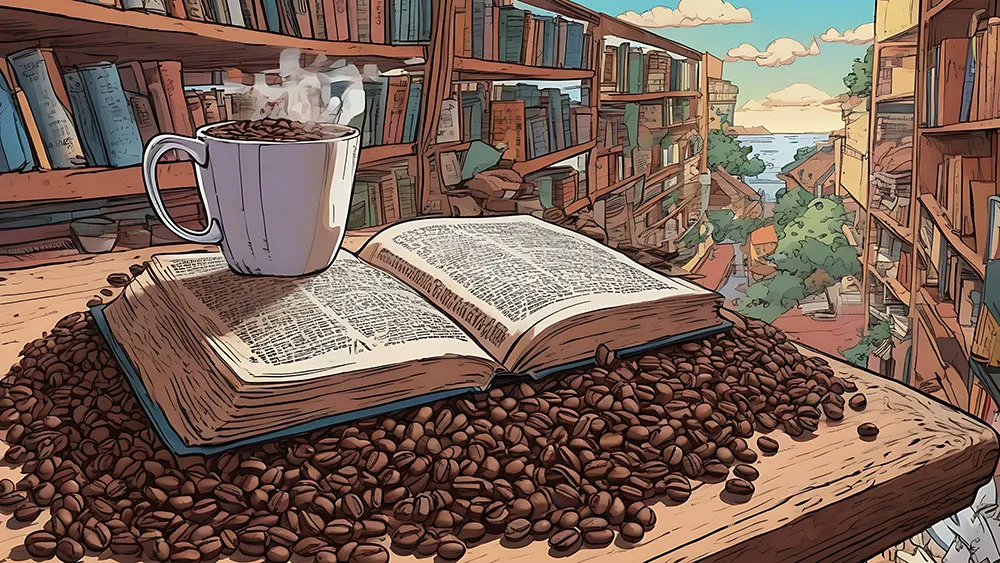
The history of coffee is far more than a simple timeline. It’s a captivating journey that began on tropical islands and transformed coffee into a powerful force in world trade. Despite facing bans and controversy, coffee rose to become a beloved beverage, sparking both fear and pleasure throughout history.
Overview
It’s truly intriguing how a small fruit, has evolved into the one of the largest commodities today.
Have you ever wondered about the origins of coffee, and the incredible journey this exotic fruit embarked upon? Brace yourself for an exploration across both time and continents.
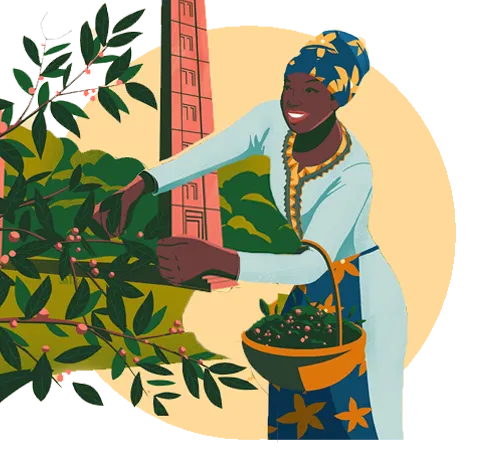
What we will cover
Following the discovery of coffee in Africa, coffee ventured towards the west, captivating emerging civilizations in Europe, and simultaneously found its roots in the east in Asia.
The question remains: How did this fruit manage to infiltrate every corner of the globe?
This article will explore the captivating history of coffee, from its humble origins in Ethiopia to its status as a global phenomenon.
We will delve into the myths and legends surrounding its discovery, trace its spread across continents, and examine the cultural and social impact of this remarkable beverage.
So, grab a cup, and lets get into it!
ContentsCoffee Origins
What is the origin of coffee? The origin of coffee can be traced back to the ancient coffee forests of Ethiopia, where it is believed that coffee was first discovered.
From there, it moved to Yemen in the 15th century. By the 16th century, people in places like Persia, Egypt, Syria, and Turkey knew about coffee.
There are several myths about the person who first discovered coffee. Let’s start with the most popular version of the Kaldi myth.

The Myth of Kaldi
The most popular origin story of our beloved beverage begins with Kaldi and his goats somewhere around 850 CE.
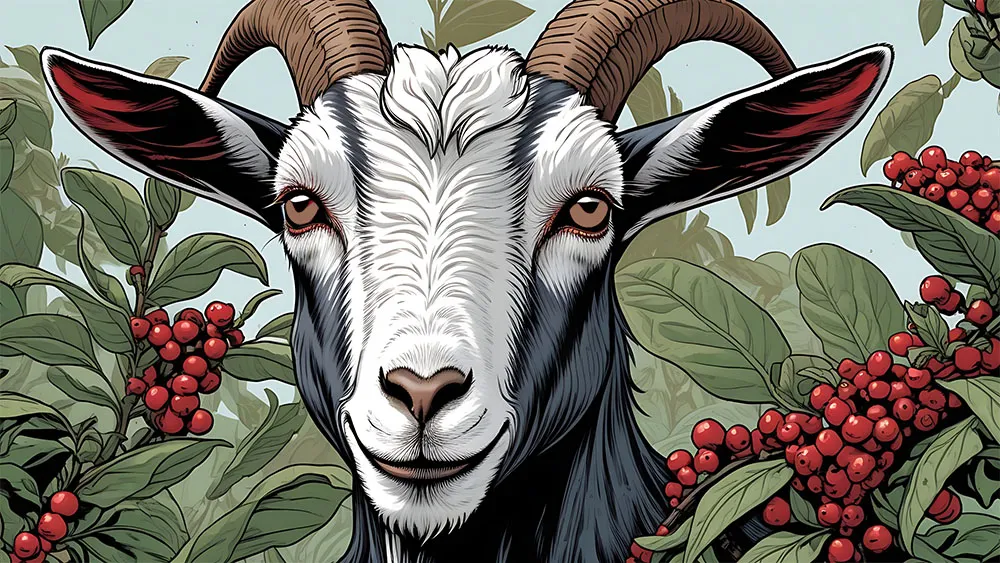
Kaldi, an Ethiopian goat herder, observed an unusual behavior in his goats – they were dancing!
This peculiar sight led him to discover that the cause was the red fruits, roughly the size of cherries, they were consuming.
Intrigued, Kaldi decided to taste the fruits himself and experienced sleeplessness that night.
Excited by this revelation, he gathered some of the fruits the next day and brought them to a nearby monastery, hoping to share his discovery.
However, the monk there disapproved and cast the fruits into the fire.
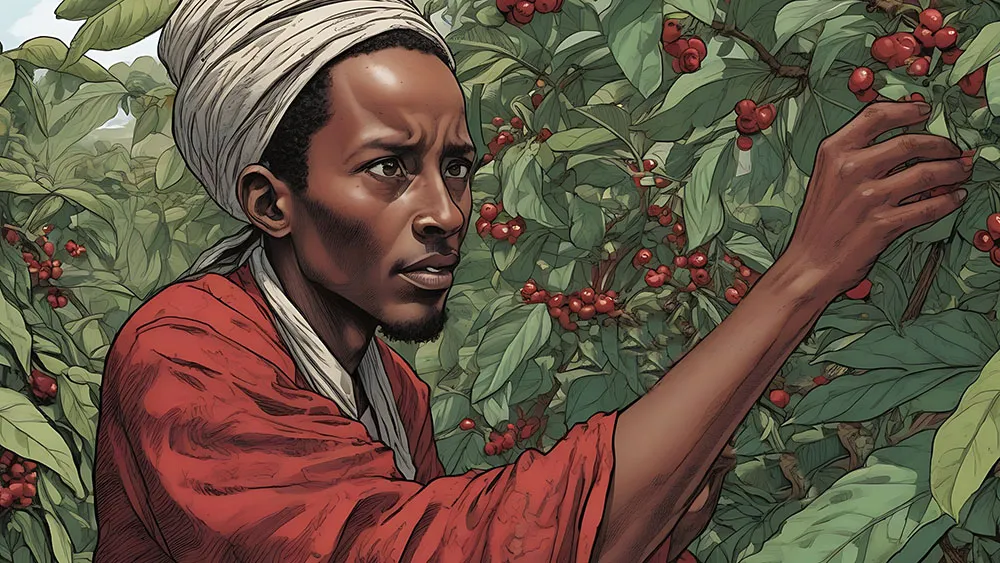
As the fruits burned, an incredible aroma wafted from the fire, signaling the beginning of something extraordinary.
The result was the world’s first roasted coffee, emanating a delightful fragrance.
Undeterred by the monk’s disapproval, Kaldi’s aromatic creation captured the monk’s curiosity.
The monk tasted the concoction, finding it delightful, and eagerly shared it with his fellow monks. This marked the beginning of the dissemination of knowledge about the magical beverage.
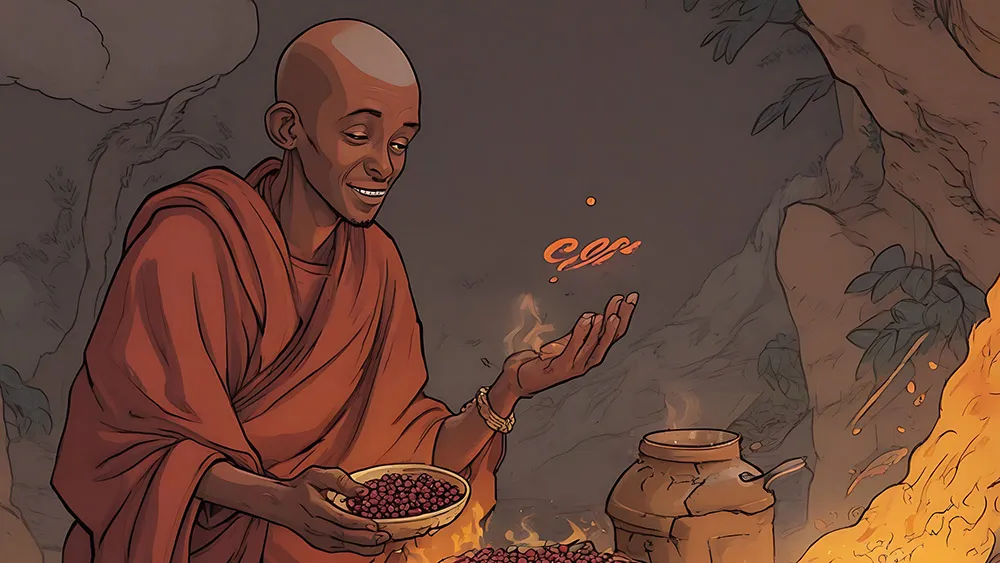
As the monks engaged in their newfound coffee ritual, a serene warmth enveloped them. The effects were transformative, granting them the ability to stay awake and partake in profound discussions for extended periods.
Though Kaldi’s story may exist in the realm of symbolic and unverifiable history, one undeniable truth emerges – the origins of coffee can be traced back to the mystical lands of Ethiopia.
The aromatic journey, from Kaldi’s curious goats to the tranquil monastery, marked the inception of a beverage destined to captivate hearts and minds throughout the ages. [3, 6, 7, 9]

Oromo Tribe and Coffee’s True Origins
While the exact origin of coffee is a mystery, compelling evidence suggests the Oromo tribe, a historically nomadic group residing in Ethiopia, may have been the first to discover the energizing properties of the coffee plant.
Their unique relationship with coffee transcended simply a beverage; it became deeply embedded in their culture, playing a vital role in their daily lives and even in times of war.
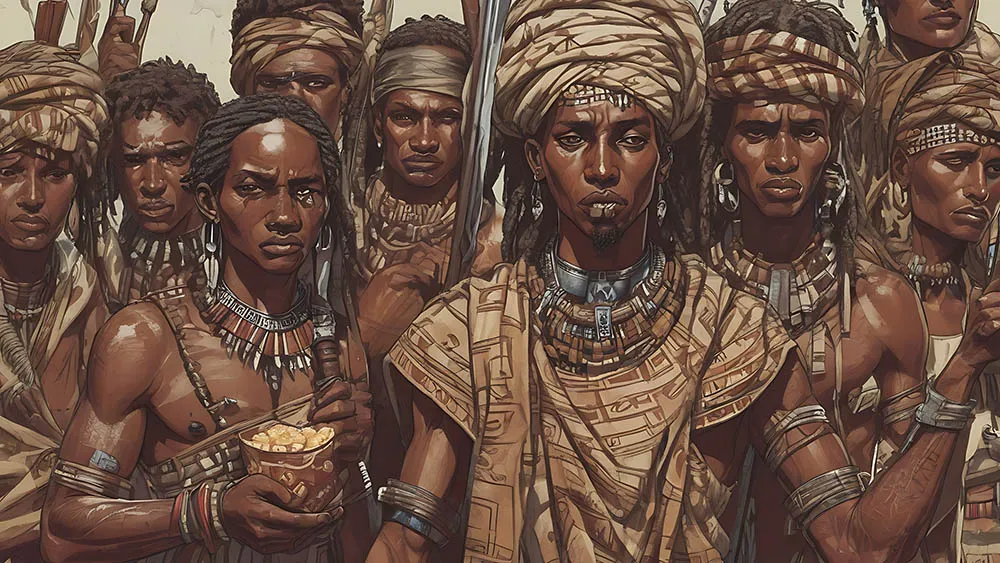
The Ritual of “Buna Qalaa”
The Oromo people traditionally practiced “Buna Qalaa,” which translates to “coffee slaughtering.” This wasn’t your typical coffee.
Imagine a potent blend of ground coffee beans, rich ghee (clarified butter), and sometimes salt, meticulously shaped into energy bars.
These bars served as a vital source of sustenance for Oromo warriors, fueling their strength and focus during battles and long journeys, a testament to the tribe’s deep understanding of the coffee plant’s invigorating properties. [7,9,11,12] .
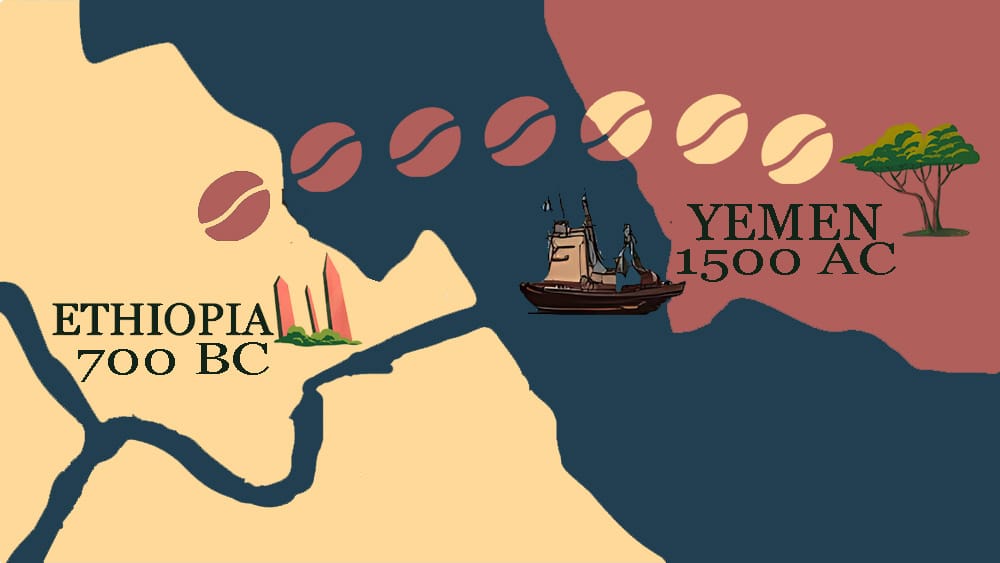
The Oromo people’s deep connection to coffee likely played a crucial role in its early dissemination beyond their community.
Several genetic analyses of coffee beans strongly support the ethiopian origins of coffee. These analyses not only pinpoint the Ethiopian highlands as the birthplace of Arabica coffee, but also where it went next – Yemen. [13]
Coffee embarked on its journey, eventually reaching the Middle East and Yemen in the 15th century.
Mocha: The Cradle of Coffee Trade
The Yemeni port city of Mocha became a central hub for coffee trade. It cradled the seeds, fostering their cultivation and exportation.
The name “Mocha” became synonymous with coffee itself, marking a significant chapter in the history of this beloved beverage.
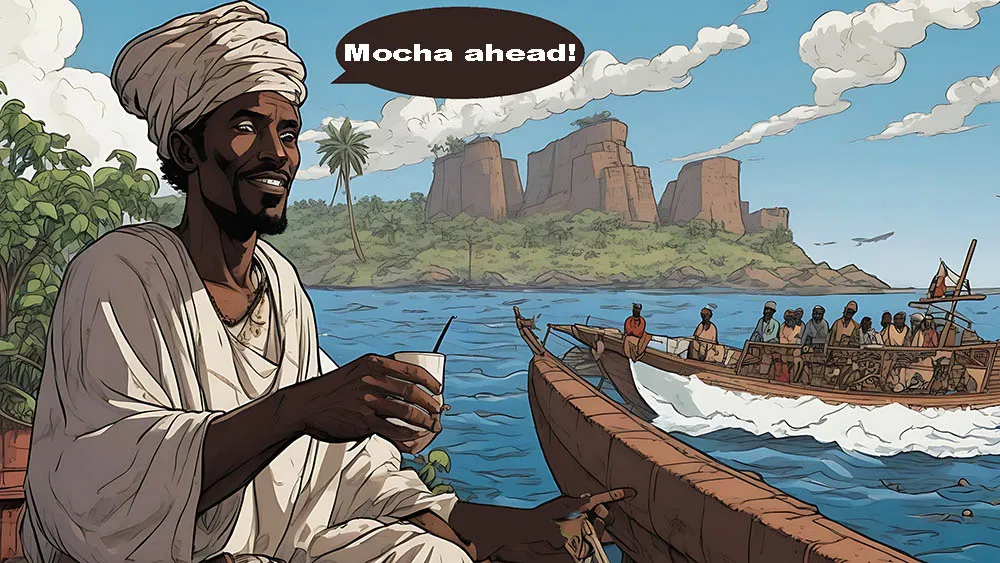
From then on, every mention of “Mocha” in coffee discussions traced back to Yemen’s shores. The beverage, known as the “wine of Arabia,” found roots in Egypt, Persia, and Turkey.
As its aroma enchanted the region, coffeehouses sprang up across Arabia, aptly named the “Schools of the Wise.”
People tell stories and share knowledge in these coffeehouses. Coffee for the first time brought strangers together.[3, 6, 7, 9]
Coffee in Ottoman Empire
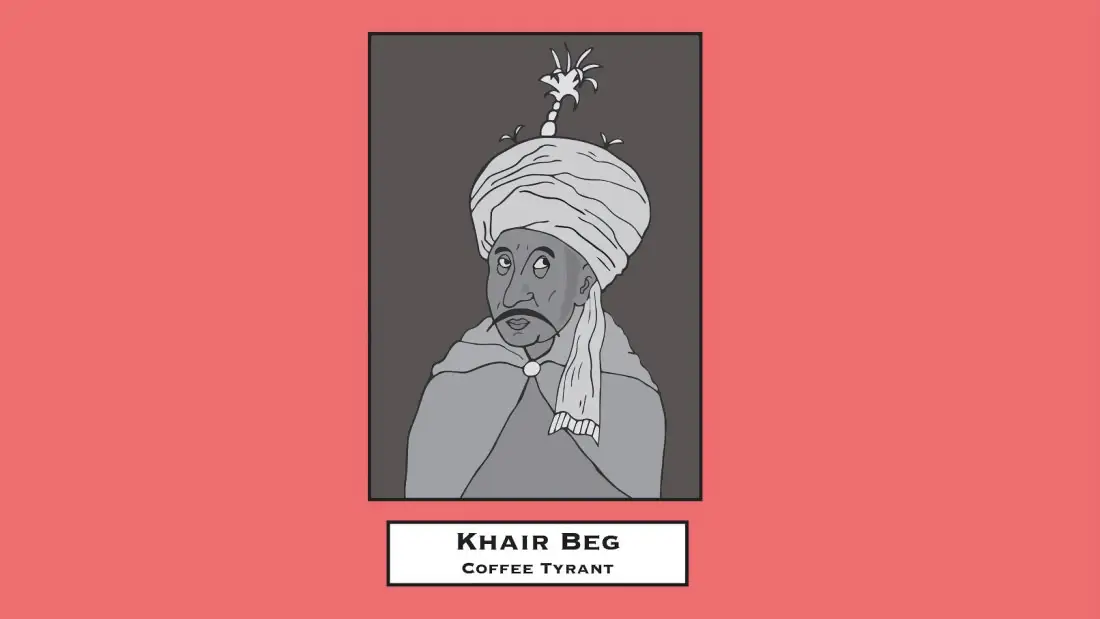
Whispers of a potent beverage first reached the Ottoman Empire in the 15th century, carried by Arab Sufi monks who found solace in its ability to keep them alert during nightly prayers. Initially considered a medicine and religious aid, coffee soon permeated everyday life.
Wealthy Ottomans indulged in elaborate coffee ceremonies within their homes, while ordinary folks found solace in bustling “kahve kanes” (coffeehouses). These vibrant hubs pulsated with conversation, entertainment, and even business deals, fostering a sense of community and lively exchange of ideas.
By the century’s end, Muslim pilgrims had carried the coffee bean’s legacy across the Islamic world, transforming it into a lucrative trade commodity. However, coffee’s popularity also ignited a controversy that simmered beneath the surface.
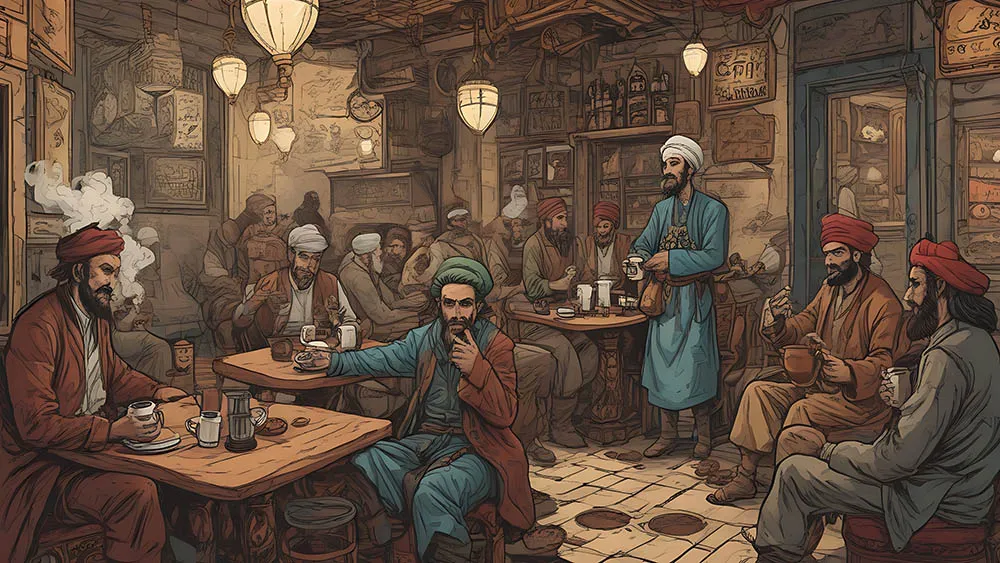
Rulers viewed the coffeehouses with a wary eye, fearing they harbored dissidents and troublemakers. Rumors swirled of “improper pastimes” like gambling and unorthodox behavior taking root within these social spaces.
In 1511, Khair-Beg, the young governor of Mecca, decided he had seen enough. He declared coffee akin to the forbidden wine, citing religious grounds, and ordered the ban of Mecca’s coffeehouses.
This decree, however, proved short-lived. The coffee-loving Sultan of Cairo intervened, promptly overturning the ban.
Yet, the seed of doubt had been sown. Similar attempts to ban coffee consumption continued throughout the 16th century, often fueled by concerns about social unrest and political dissent.
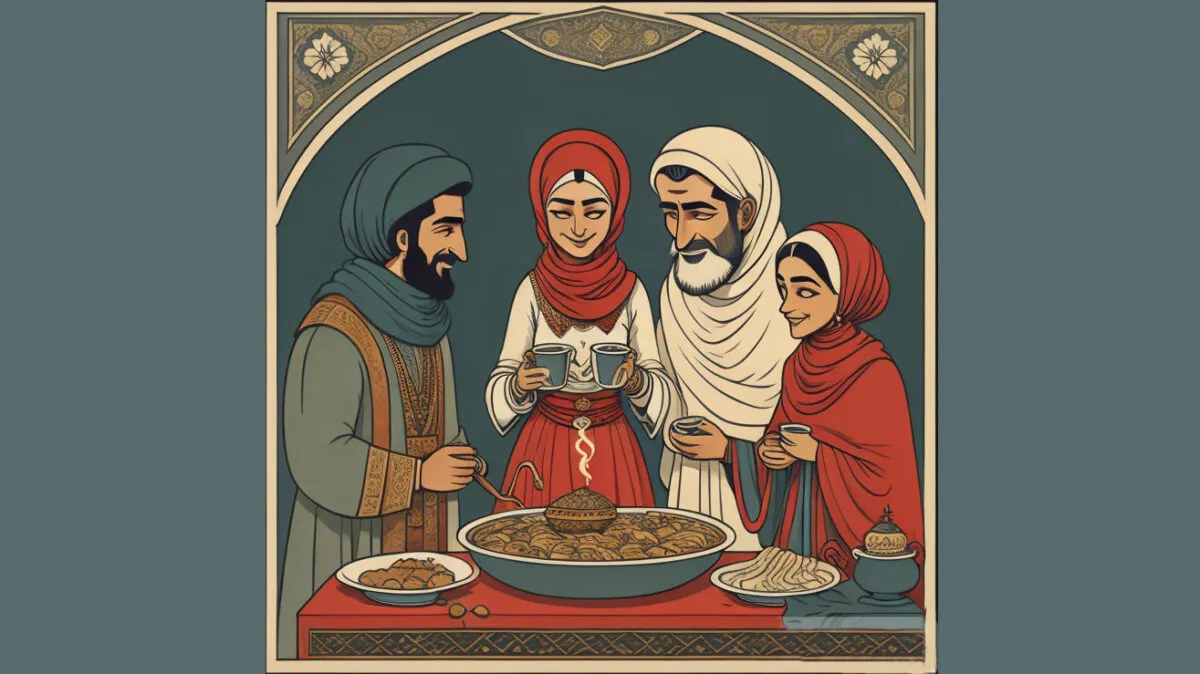
The Grand Vizier of Constantinople, for instance, fearing sedition during wartime, shuttered the city’s coffeehouses and harshly punished anyone caught indulging in the forbidden beverage. How?
By throwing the offenders into the waters of bosporus!
Despite these measures, coffee’s hold on Ottoman society only grew stronger. Beyond the addictive nature of caffeine, the drink offered a unique blend of intellectual stimulation and social connection.
It provided a pleasant energy boost without the inebriating effects of alcohol, making it an ideal companion for stimulating conversations, storytelling, and even the occasional act of irreverence towards authority.
Coffee had become deeply ingrained in the fabric of Ottoman life, its importance so recognized that insufficient coffee could even be grounds for a divorce! [3, 6, 7, 9]
Coffee in Europe and Asia
Τhe journey of coffee takes a turn as its seeds spread both eastward, reaching India and Indonesia, and westward, reaching Italy and the rest of Europe.
But to venture even further and conquer additional continents, it will take a courageous monk and a papal approval.
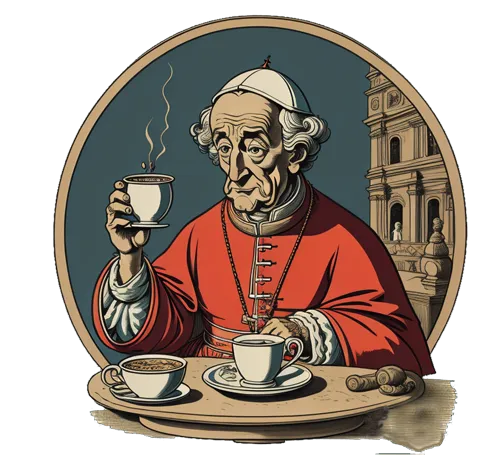
How Asia Changed the History of Coffee
For centuries, Arabia kept coffee a secret, fiercely guarding their prized beans. Exports were limited and only flowed through the bustling Yemeni port city of Mocha.
To further safeguard their monopoly, Arabs reportedly employed a method of treating coffee beans before export, rendering them infertile and preventing independent cultivation elsewhere.

In 1670, a religious man named Baba Budan defied the rules! On his journey, he smugled seven valuable coffee seeds back to India, defying Arabia’s monopoly.
Legend has it that he cleverly concealed them within his robe, paving the way for coffee’s remarkable journey in the East.
Thanks to India’s perfect climate, Baba Budan’s seeds thrived. The coffee grown into huge coffee farms, which are still a big part of India’s agriculture today.
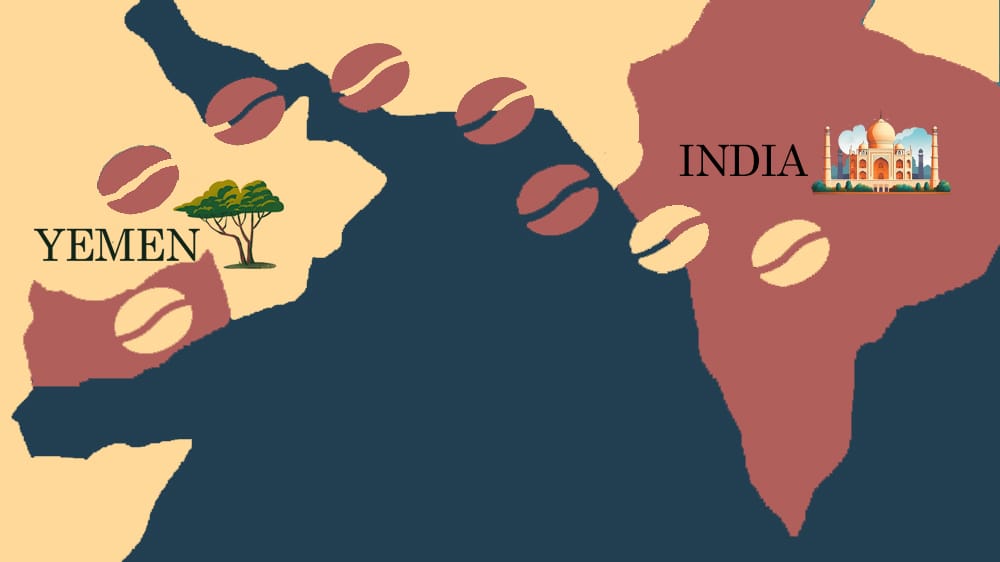
Meanwhile the Dutch, undeterred by previous setbacks in Ceylon (present-day Sri Lanka), also managed to establish themselves in the coffee trade. In 1616, they transported a coffee tree from Aden to Holland, allowing them to begin cultivation in Ceylon in 1658.
Soon after, Dutch efforts expanded further, with coffee being transplanted to Java, Sumatra, Celebes, and other islands in the East Indies. For many years, the production of the Dutch East Indies, heavily reliant on Indonesian islands like Java, determined the price of coffee in the world market.

By the 18th century, Java and Mocha had become synonymous with high-quality coffee.
Despite Arabia’s efforts to control the coffee trade, the allure of the bean proved irresistible. Enterprising individuals and ambitious powers began to challenge Arabia’s monopoly, paving the way for coffee’s journey across continents. [3, 6, 7, 9]
The “Devil’s Drink”
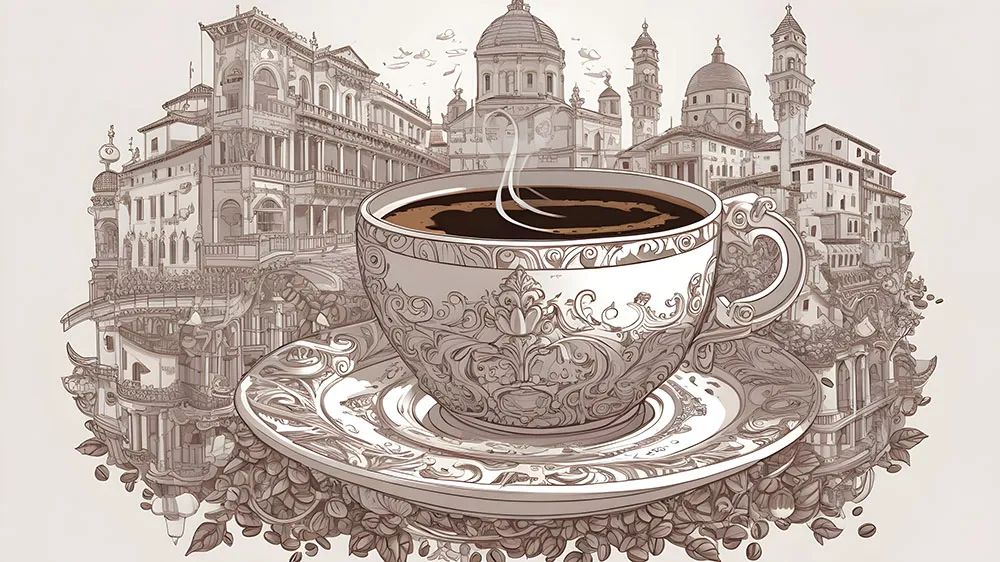
In the year 1570, a small but powerful bean made its grand entrance into the enchanting city of Venice. The aroma of this mysterious elixir began to swirl through the air, capturing the senses of the Venetian people and swiftly gaining popularity, as is its wont.
Amidst the winding streets and bustling canals of Venice, the church started to take notice of the growing allure of this dark elixir.
Local clerics, quick to associate the unfamiliar with the diabolical, deemed this new concoction a product of the Ottoman infidels—a brew from the hands of unbelievers!
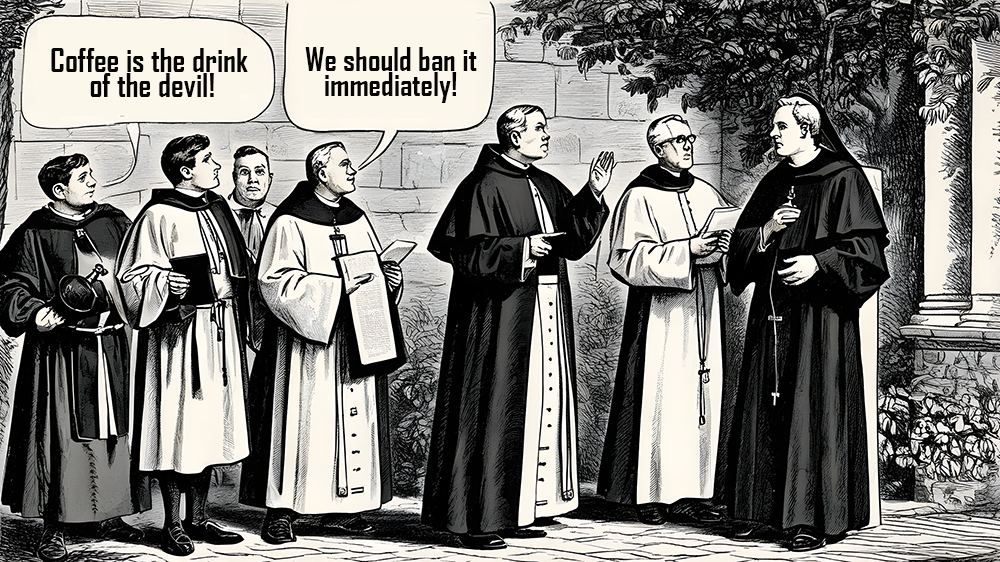
In response to the rising whispers about the “devil’s drink,” Pope Clement VIII, a man of both curiosity and authority, decided to investigate the matter himself. The scene was set as the Pope, surrounded by the grandeur of the Vatican, prepared to confront the alleged elixir.
As the Pope brought the cup to his lips, the aroma proved not of brimstone but of a delightfully pleasing and enticing nature.
The unexpected temptation led Pope Clement VIII to taste the “brew of the devil.” After savoring the unfamiliar flavor, he made a surprising declaration.
This beverage is so delicious that it would be a shame to let the unbelievers have exclusive use of it. We shall deceive the devil by baptizing it and making it a truly Christian drink. Thanks be to God for this creation!Pope Clement VIII
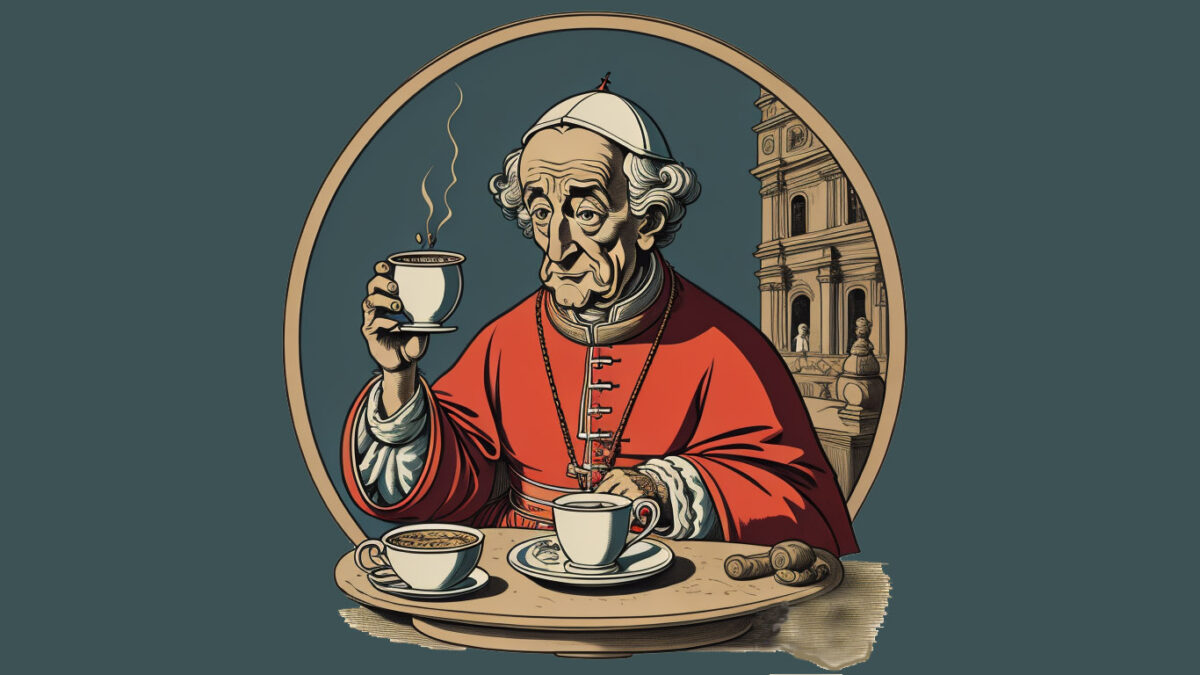
The Pope’s endorsement triggered a ripple effect across Europe in the following century.
Once called the “devil’s drink,” coffee became a beloved Christian beverage after Pope Clement VIII approved it. This blessing sparked the opening of coffeehouses across Europe, turning them into popular social spots.
The coffee invasion of Europe had officially begun. [3, 6, 7, 9]
European History of Coffee
As the 1600s unfolded, coffeehouses sprouted across Europe in England, Austria, France, Germany, and the Netherlands.
England “Penny Universities”
In England, the Coffee Tale unfolds with a unique flavor. Inspired by Arabian coffeehouses, they transformed into vibrant social hubs, aptly dubbed “Penny Universities.”
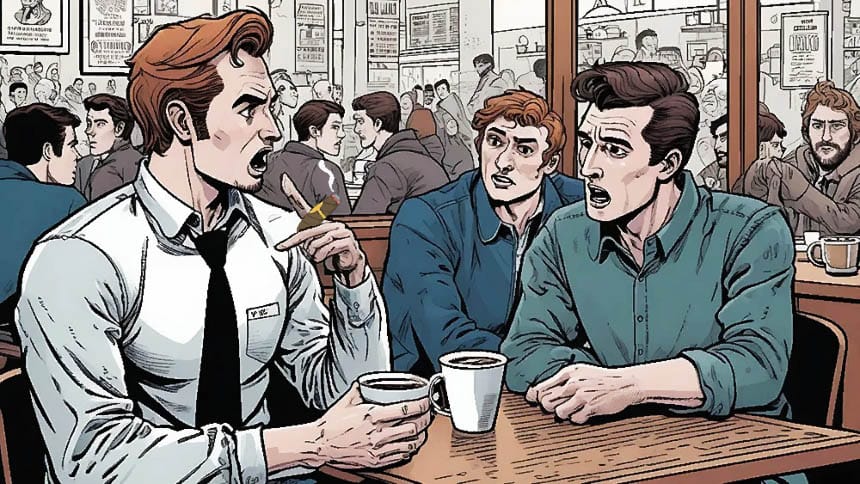
A cup of coffee granted entry to a realm of knowledge—political discourse and social tidings exchanged with every sip.
In Oxford, the first coffee club in England opened. This establishment would later be known as the Oxford Coffee Club, where significant ideas and innovations were created and shared. The Oxford Coffee Club eventually grew into The Royal Society.
Notable among these was Edward Lloyd’s Coffee House, which evolved into a corporate giant, birthing the fusion of caffeine and commerce.
In Oxford, the birthplace of the first English coffee club, ideas were brewed like the finest roast. The Oxford Coffee Club matured into The Royal Society, a testament to the intellectual power fueled by coffee.
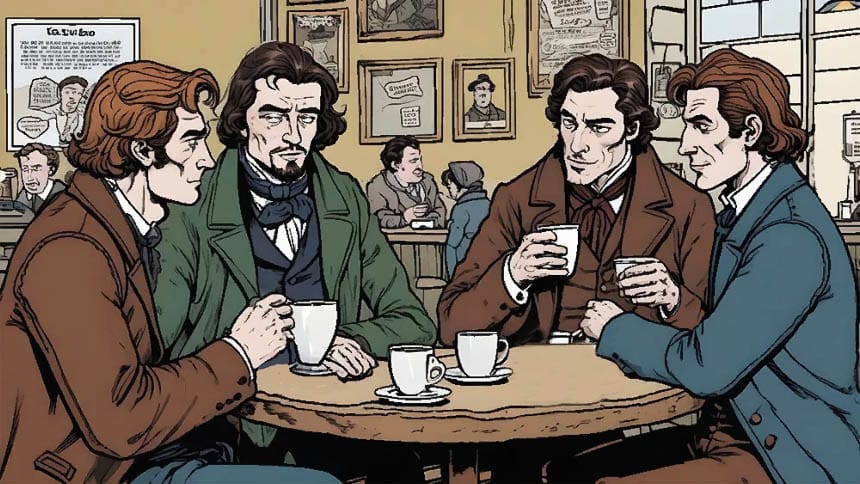
For English men, coffeehouses became their sanctuaries—where work and camaraderie flowed, leaving the pubs in the shadows. Yet, for the women of the era, discontent brewed like a storm.
While their husbands spent hours talking over coffee at coffee shops, the wives at home were not happy. In 1674, they even wrote a petition, called the “Women’s Petition Against Coffee”, to try to get rid of coffee and have their husbands back home.
This isn’t just a story about coffee as a drink. It’s about how coffee sparked lively discussions, changed societies, and even caused some trouble at home for some people! [3, 6, 7, 9]
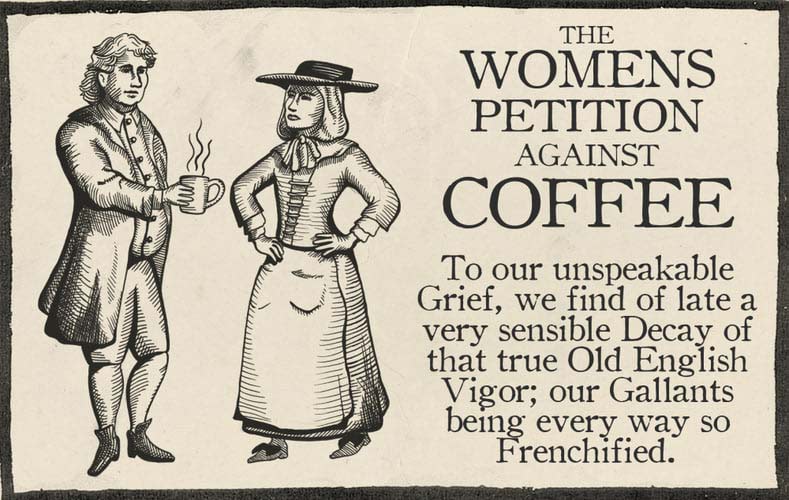
Coffee Conquers France
In the 17th century, France, like many other European nations, succumbed to the allure of coffee. The credit for its introduction often goes to Sully Mehmed Pasha, the Ottoman ambassador to King Louis XIV in 1664.
French fascination with all things exotic, coupled with the growing popularity of coffee houses throughout Europe, created the perfect storm for coffee’s acceptance.
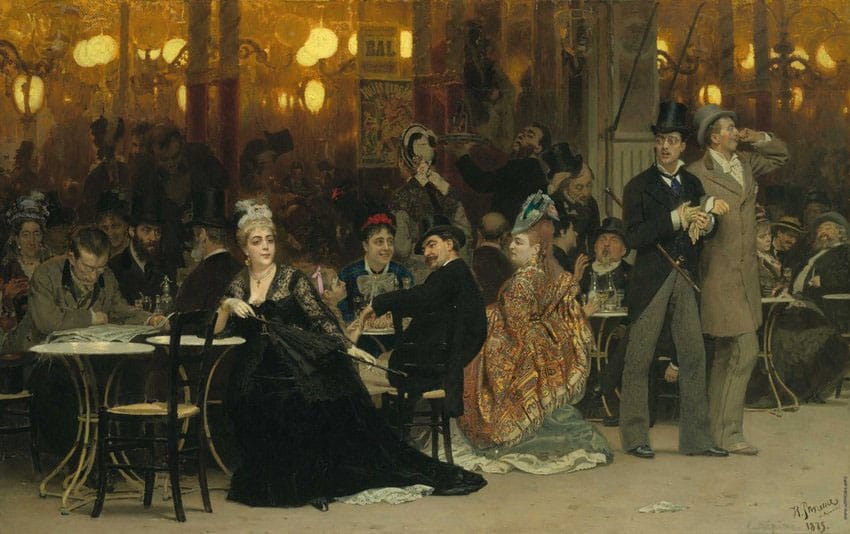
French coffee culture blossomed in the elegant cafes that lined the bustling streets of Paris.
These cafes weren’t just places to grab a drink; they became vibrant social centers where artists, philosophers, and intellectuals gathered to exchange ideas, fuel lively debates, and even conduct business deals.
Coffee fueled the French Enlightenment, acting as a muse for some of the greatest minds of the era.
Famous Parisian Coffee Houses:
- Café Procope: Established in 1686, this historic cafe is considered one of the oldest in Paris. Literary giants like Voltaire, Rousseau, and Victor Hugo were all known to frequent Procope, making it a haven for artistic expression and intellectual discourse.
- Les Deux Magots: Founded in 1812, Les Deux Magots became a favorite haunt of writers and artists like Ernest Hemingway, Jean-Paul Sartre, and Simone de Beauvoir. The cafe’s distinctive red awnings and Art Deco interior continue to attract visitors seeking a taste of Parisian literary history.
- Cafe de Flore: Opened in 1884, Cafe de Flore is another iconic Parisian establishment. Pablo Picasso, Jean-Paul Sartre, and Simone de Beauvoir were all regulars, solidifying the cafe’s reputation as a hub for the existentialist movement. Today, Cafe de Flore remains a popular spot for people-watching and enjoying a classic cup of French coffee.
French coffee culture is known for its appreciation of quality and tradition. While espresso drinks have gained popularity in recent years, classic methods like cafe filtre (drip coffee) and cafe au lait (coffee with steamed milk) remain staples on most cafe menus.
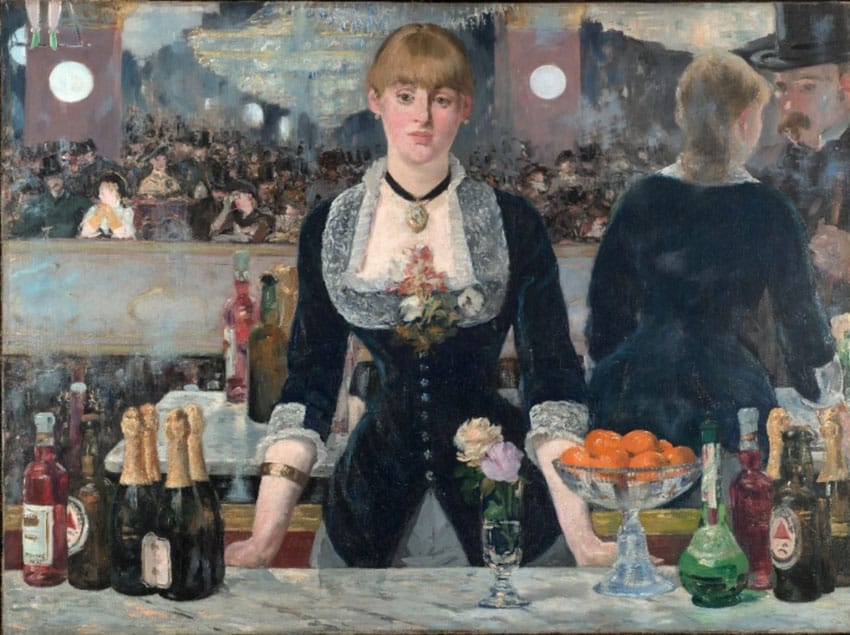
In 1669, Paris fell in love with coffee. Just like everything else during King Louis XIV’s fancy reign, coffee became a symbol of their culture.
Vienna “Blue Bottle”

Vienna’s embrace of coffee came later than its European counterparts. In 1683, facing a looming invasion, the city turned to Georg Franz Kolschitzky, a seasoned traveler familiar with the Arab world, to seek aid from Polish allies. Disguised as a Turk, Kolschitzky navigated enemy lines, playing a crucial role in Vienna’s defense.
Following the Turks’ retreat, the Viennese stumbled upon a peculiar windfall – hundreds of sacks filled with strange-looking beans. Mistaken for mere camel feed, and having no use of camels, the beans were about to be burned. But then, a familiar aroma reached Kolschitzky’s nose.
Holy Mary!” he exclaimed, “That’s coffee you’re burning! If you don’t know what it is, give it to me. I can certainly find a good use for it!Mark Pendergrast, Uncommon Grounds: The History of Coffee and How it Transformed Our World
Kolschitzky, thanks to his knowledge of Turkish customs, knew how to roast, grind, and brew the beans. He soon opened the “Blue Bottle,” one of Vienna’s first coffee houses. His coffee, inspired by the Turkish style, was sweet, but he also introduced innovations like filtering the grounds and adding milk, adding his own unique touch to the beverage.
In the following decades, coffee became deeply ingrained in Viennese culture, acting as a catalyst for intellectual pursuits. Coffee houses emerged as vibrant hubs for animated discussions, gradually replacing the boisterous atmosphere of beer halls. [7, 8]
Coffee arrives to America
Having already conquered Africa and the nations of the Indian Ocean, sweeping across Europe, coffee was destined to make its way even further west to conquer every nation touching the Atlantic Ocean.
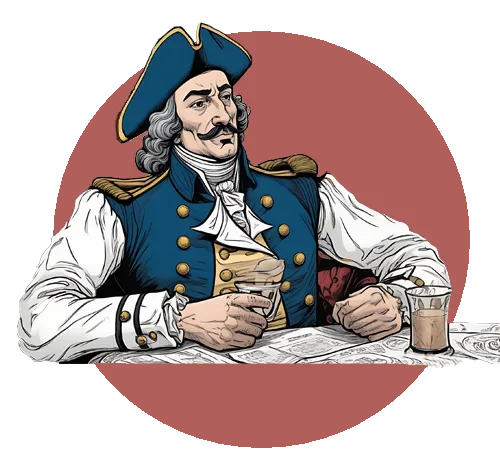
Coffee Crosses the Atlantic Ocean
In the early 18th century, the Dutch decided to display generosity in a way that would forever change the world of coffee cultivation.
In 1714, the mayor of Amsterdam presented King Louis XIV of France with a coffee plant. While the Dutch couldn’t cultivate coffee trees in their homeland, they ingeniously preserved them in specialized greenhouses.
This specific plant sought sanctuary within the protective confines of the Royal Botanical Gardens of Paris.
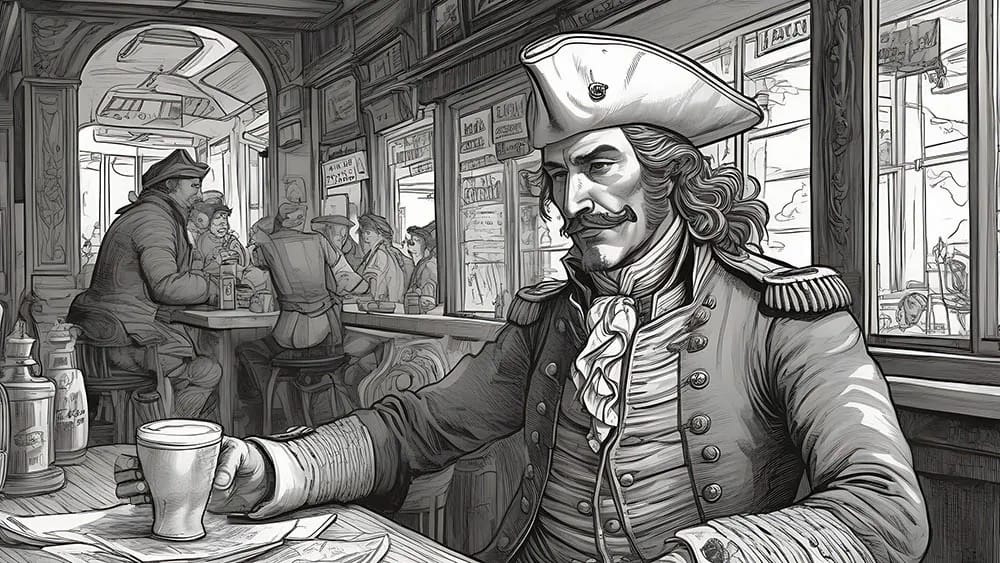
During this period, a captain in the French Navy, Gabriel de Clieu, was in Martinique but visited Paris.
Whether he cunningly acquired seedlings from the sheltered coffee tree of King Louis XIV or received direct instructions from the monarch to initiate a coffee plantation in Martinique, the details of Gabriel de Clieu’s venture into the world of coffee cultivation remain a mystery.
Nevertheless, de Clieu acquired the seedlings and embarked on a voyage to the Caribbean, where conditions proved ideal for coffee cultivation.
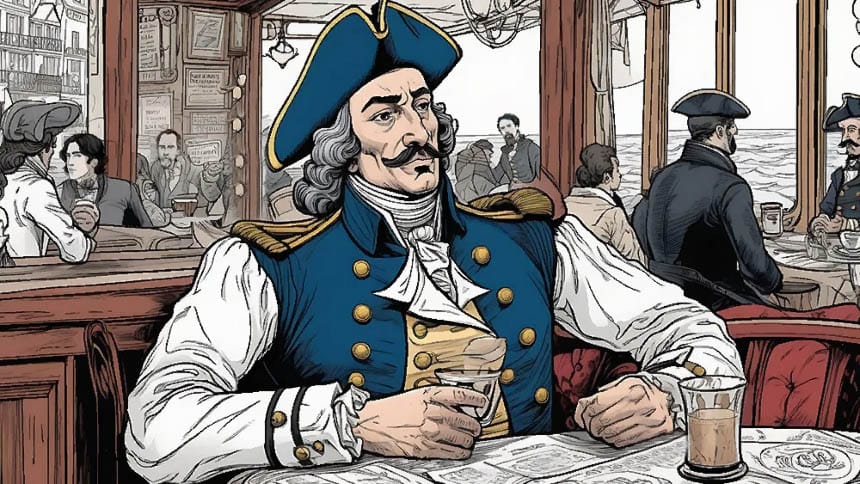
It was a perilous journey for de Clieu, who struggled to keep the plant alive.
Water was scarce on the ship, but he managed to sustain the plant by depriving himself.
Upon reaching the island, he secretly planted it among other flora to keep it safe.
After being planted, the sapling not only flourished but spread to over 18 million coffee trees on the island of Martinique in the next 50 years.
Even more incredible, this coffee tree became the ancestor of all coffee trees in the entire Caribbean, South, and Central America!
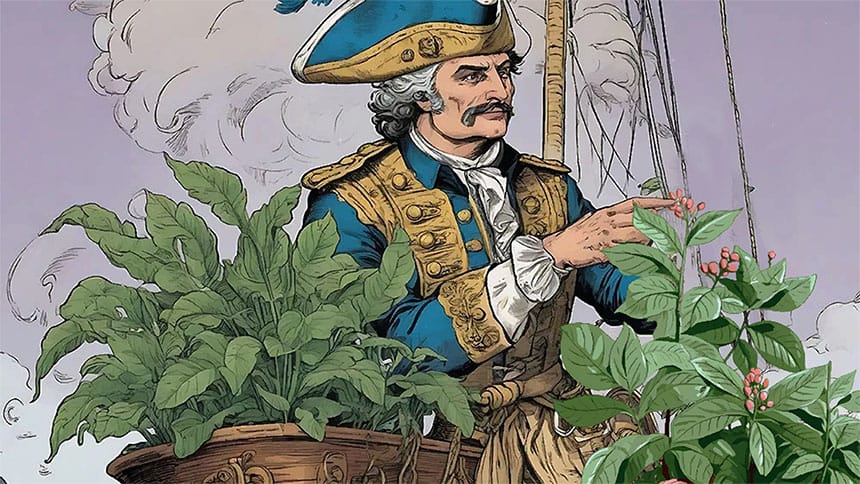
In 1730, the English Governor of Jamaica, Nicholas Lawes, brought coffee plants to his island. In a short time, coffee flourished deep in the Blue Mountains, an exceptional coffee cultivation region.
This plant would change the history of coffee and the economy of America forever.
Brazilian Coffee History
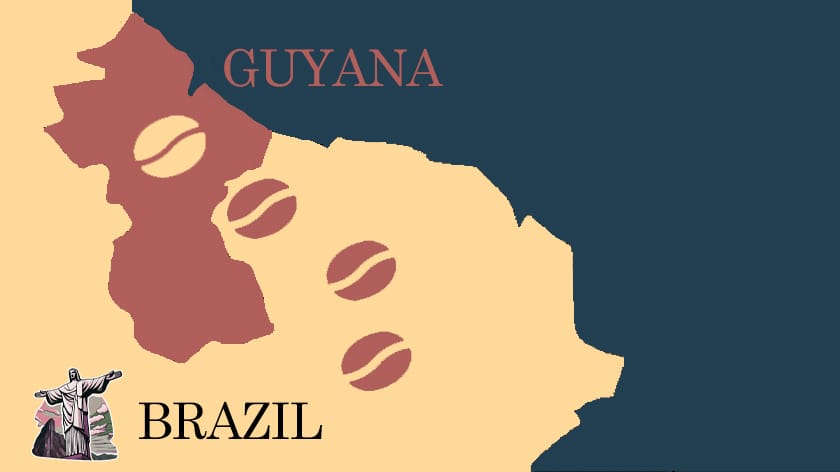
In the vast expanse of time, when Brazil was yet to emerge as the coffee titan we know today, the seeds of this extraordinary journey were sown by the tenacity of a Brazilian sergeant named Francisco Palheta.
The year was 1727, and his mission to settle a dispute in Guyana concealed a secret agenda—to acquire the coveted coffee that could transform Brazil’s destiny.
Facing rejection in his plea for coffee seedlings from the French Governor, Palheta unveiled a clandestine plan.

His charm, as rich as the Brazilian soil itself, won over the Governor’s wife. In her hand, she offered him a bouquet that held the seeds of a coffee empire.
Hidden amidst the blooms were the seeds and sprouts that would become the catalyst for Brazil’s ascendance.
Returning home, Palheta planted these covert treasures, birthing the roots of a legacy.
It took until 1822 for the seeds to bear fruit, as Brazil’s production burgeoned. By 1852, the nation claimed its throne as the world’s leading coffee producer—a reign unbroken to this very day, as most of our coffee comes from Brazil.
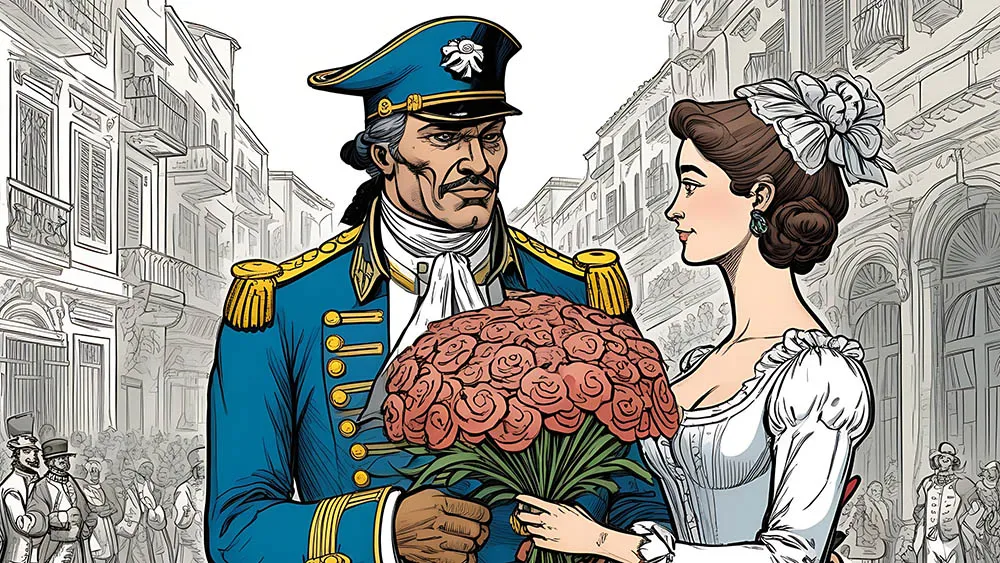
In 1893, Brazilian coffee embarked on a journey to the cradle of its existence, landing in Kenya and Tanzania.
The Brazilian magic mingled with East African soil, creating a fusion that echoed the history of coffee itself.
American Coffee History
While coffee houses sprouted in Boston and New York in the early 1700s, the Boston Tea Party (1773) became a turning point moment for America’s favorite drink.
The Boston Tea Party
Imagine the brisk winds of Boston Harbor in 1773, where a group of spirited patriots, some cleverly disguised as Native Americans, embarked on a clandestine mission. Their goal?
To protest the oppressive tax levied by the British on tea. This led to the famous Boston Tea Party—a bold act of rebellion that reverberated through history.
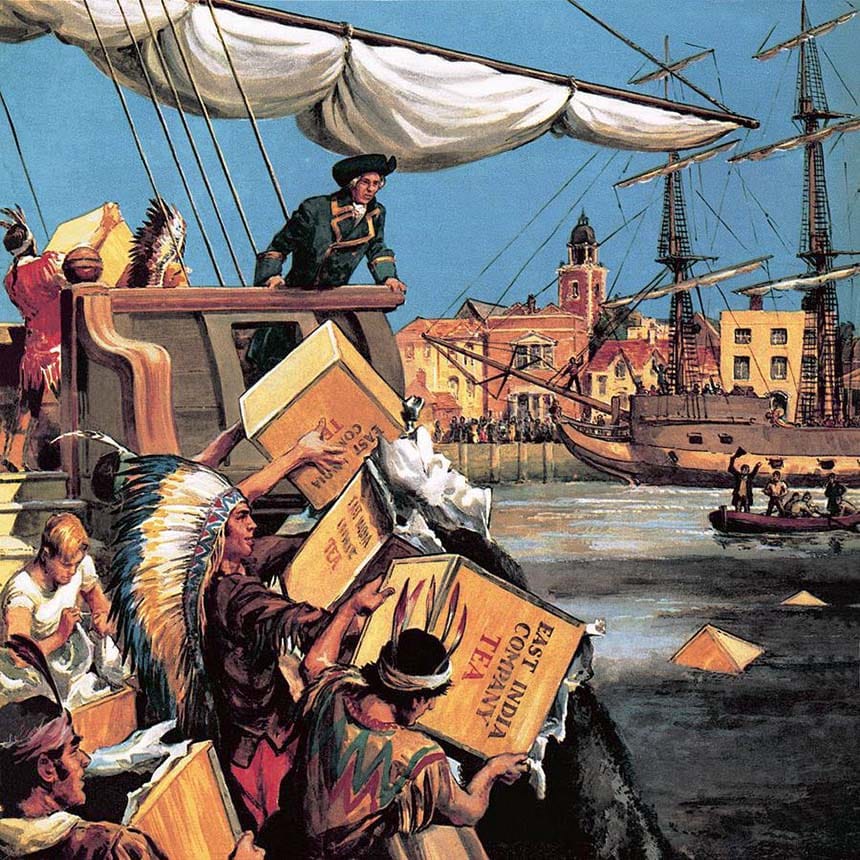
As crates of British tea sank into the harbor’s depths, the colonists sent a clear message: tea, once a cherished staple, had become a symbol of British tyranny. In its place, a new American favorite emerged: coffee.
This shift wasn’t merely about changing drinks; it signified the beginning of a coffee culture that would come to define the American palate.
The aromatic allure of coffee beans replaced the once-revered tea leaves, and the United States embarked on a journey that would forever intertwine its destiny with the global coffee industry.
The aromatic allure of coffee beans swiftly replaced tea, marking a turning point in American history. Following the Boston Tea Party, coffee not only became the drink of choice for many colonists, but it also symbolized resistance and independence.
As the country’s love for coffee grew, the United States would become forever intertwined with the global coffee industry.
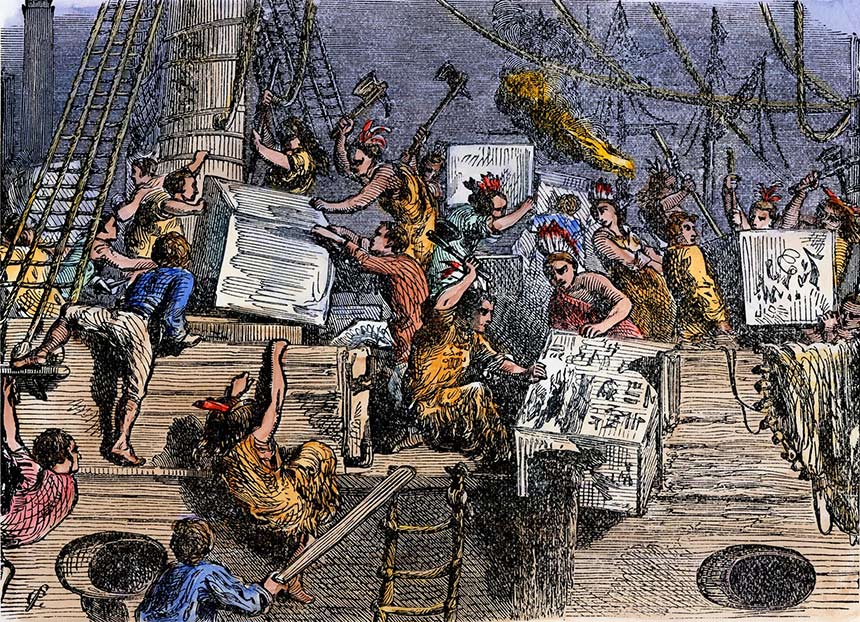
Fast forward through the pages of history, and you find a nation that not only embraces coffee as its chosen brew but also shapes the landscape worldwide.
The economic currents ripple far beyond its shores, impacting countries in South and Central America, where coffee cultivation thrives.
The Boston Tea Party wasn’t just a political act; it had a profound impact on daily life. In 1774, just a year after the rebellion, John Adams, one of the Founding Fathers, recounted a telling experience in a letter to his wife Abigail.
After a long journey, he politely asked his hostess, Mrs. Huston, for tea. Her response exemplified the growing sentiment against British goods:
No sir, said she, we have renounced all Tea in this Place. I can’t make Tea, but I can make you Coffee.John Adams letter to his wife Abigail, 1774
This simple yet powerful exchange reflects the widespread boycott of tea in colonial households. Adams, acknowledging the shift, remarked:
Tea must be universally renounced. I must be weaned, and the sooner, the better.John Adams to Abigail Adams, 1774 [14]
The resolve to abandon tea and embrace coffee reflected the broader movement toward American independence, even in small, everyday routines.

Fast forward to 1817, when coffee plants made their way to the lush landscapes of Hawaii, sparking whispers of a new agricultural revolution.
This event, coupled with America’s growing love for coffee following the Boston Tea Party, fueled the potential for Hawaii to become a major coffee producer.
Even before coffee took hold in Hawaii, it was already gaining favor among American elites. In 1824, Thomas Jefferson, a known coffee enthusiast, expressed his appreciation for the beverage in a letter to Edmund Rogers. He wrote:
… the coffee bean, from it’s mild, and smooth, bitter, it’s essential oil & the aroma that gives it is become the favorite beverage of the civilised world.Thomas Jefferson to Edmund Rogers [Letter], 1824
However, the letter’s focus is on the quality of coffee beans. Jefferson emphasizes the difference between well-ripened beans and unripened green coffee, highlighting the importance of taste and aroma. [15]
Brazilian hands planted the seeds of change, and by 1825, the verdant hills boasted the birth of the inaugural coffee plantation.
By 1825, the first coffee plantation was established on the verdant hills of Kona, marking the beginning of Hawaii’s legacy in the global coffee world. This development connected the islands to a rapidly expanding international market, cementing the United States’ role as both a consumer and producer of coffee.
Coffee Machines History
In the 19th century, coffee stood as a global sensation, traversing continents with its rich aroma and robust flavor.
While the coffee bean itself had minimal territories left to conquer, the brewing, roasting, and packaging innovations of the past two centuries have profoundly shaped our coffee experience.

The Rise of Coffee Machines
The first revolutionary step in coffee preparation during the Industrial Revolution was the percolator.

In 1818, a Parisian metalworker crafted this device, setting the stage for our contemporary coffee rituals. Over time, subtle enhancements have refined its functionality.
This percolator found its way to the United States in 1865 when James H. Nason patented the first American-made percolator.
Enter the Coffee Roaster
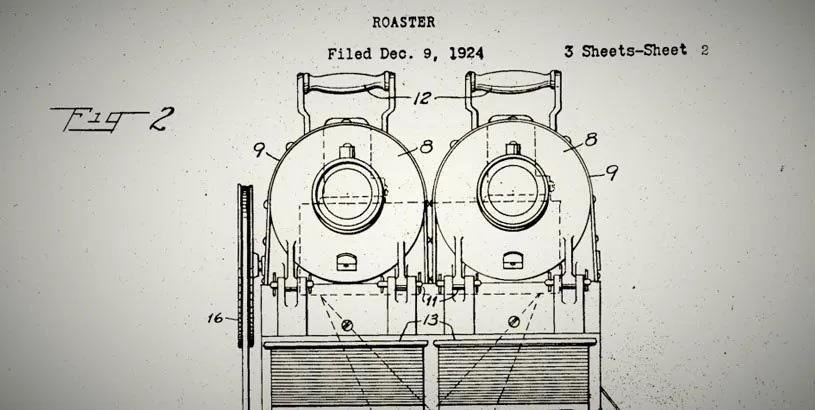
In 1864, Jabez Burns of New York introduced the first “modern” coffee roaster. This innovative approach allowed coffee beans to be roasted without direct exposure to an open flame, signaling a new era in the industry.
Arbuckle Coffee History
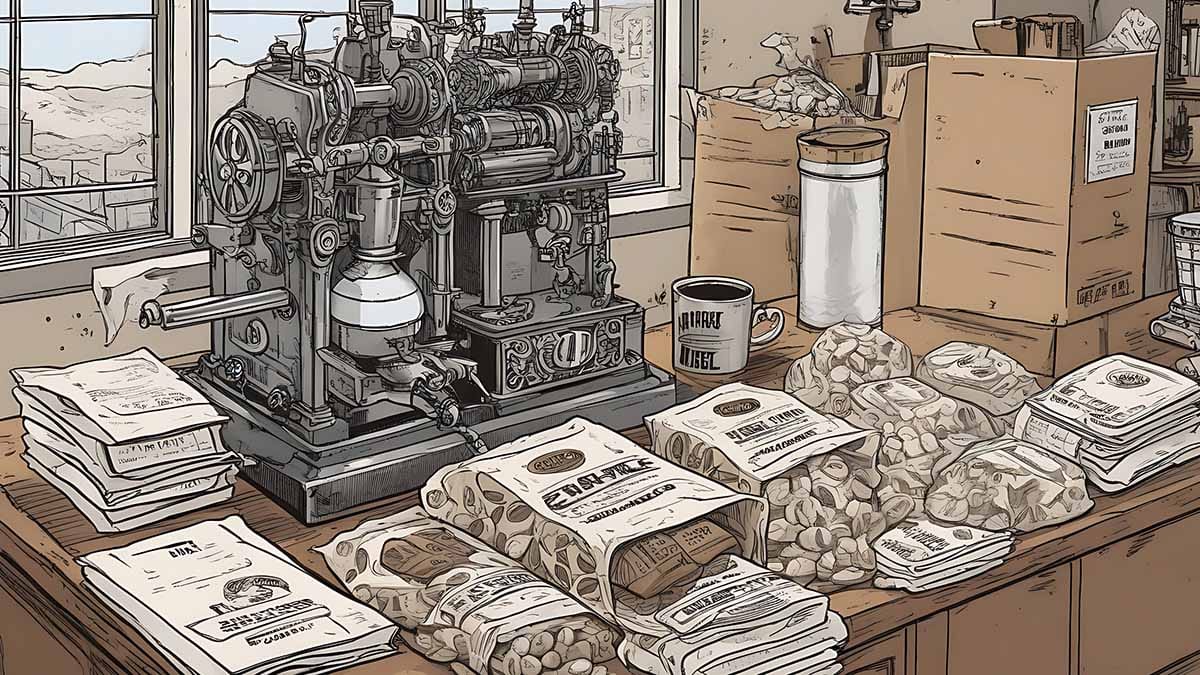
Burns’ invention, patented in 1871, set the stage for John Arbuckle to develop a machine in 1871 that filled, weighed, and sealed coffee in paper packaging.
Arbuckle swiftly became the world’s foremost coffee importer, dominating global trade routes.
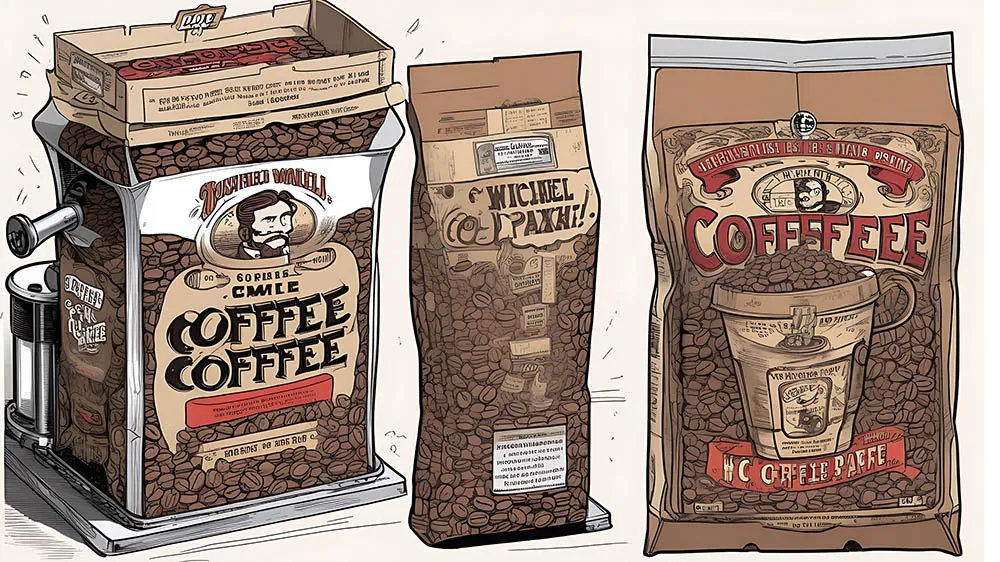
In 1886, the iconic Maxwell House brand emerged, named after the renowned Maxwell House Hotel. Maxwell House instant coffee became a wartime staple during World War II.
The First Espresso Machine
The invention of the first espresso machine in 1901 by Luigi Bezzera marked a transformative moment in coffee history.
Bezzera’s machine utilized water and steam under high pressure for rapid coffee preparation.
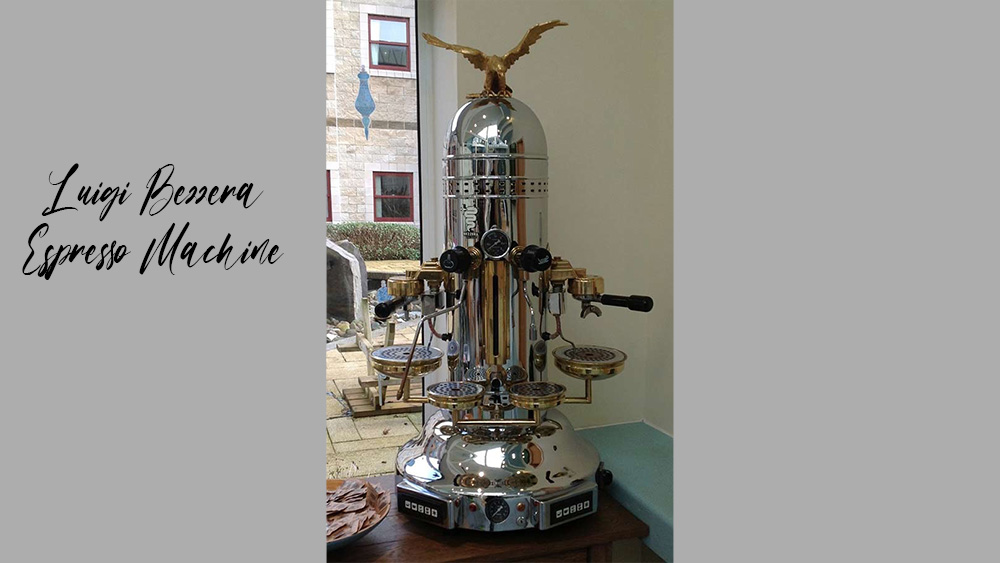
In 1905, Desiderio Pavoni acquired the patent for Bezzera’s original espresso machine, determined to enhance its performance.
Recognizing the bitterness produced by steam and high temperatures, Pavoni set a temperature limit of 195 degrees and a pressure exposure of 9 BAR.
Cappuccino Invention – Gaggia
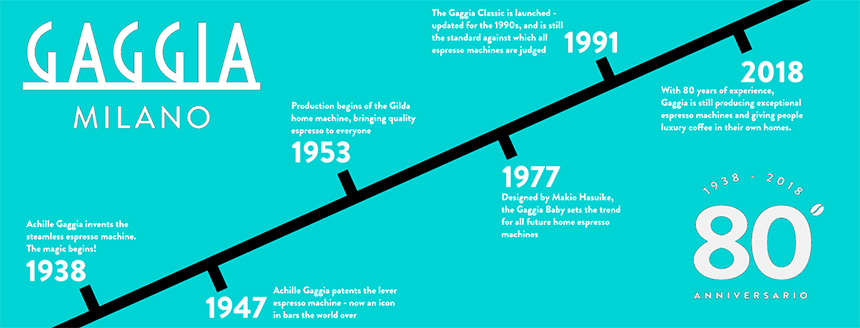
Forty years later, Italian Achille Gaggia elevated the espresso machine further by introducing a piston mechanism, producing a layer of crema atop each espresso shot and giving birth to the beloved cappuccino.
The invention of Coffee Filters

In 1908, Melitta Bentz transformed the coffee landscape with her ingenious creation: the first paper coffee filter, crafted from her son’s school papers. This marked a pivotal moment, earning her a patent and inspiring entrepreneurial ventures as she founded her own company.
Melitta’s visionary leap revolutionized brewing, reflecting her tenacious spirit and commitment to enhancing the coffee ritual.
Her invention gained widespread acclaim, securing her a lasting legacy in coffee history and influencing how enthusiasts savor their brews for generations. [5, 7]
Origin of Nescafe

In the early 1900s, Brazil enlisted Nestle’s aid to address excess coffee waste. Extensive research culminated in the creation of instant coffee through freeze-drying, birthing the global giant, Nescafe.
The 1920s witnessed a surge in sales during U.S. Prohibition. In 1926, the Science Newsletter proclaimed coffee not only an energy booster but also health-beneficial. [2, 7]
Second Wave Coffee
During the 1960s, coffee underwent another revolution.
With the help of Starbucks, we entered the initial stage of specialty coffee.

History of Peet’s Coffee
Alfred Peet, a Dutch-American, embarked on a journey to California, bringing his family’s coffee heritage to life with the establishment of Peet’s in Berkeley in 1966.
A pivotal moment unfolded in 1971 when Peet generously shared his profound coffee knowledge and roasting techniques with friends who, captivated during the Christmas season, soon opened their own coffee shops.

With Peet’s approval, these friends replicated the coffee magic in Seattle, naming their store Starbucks as a tribute to Peet’s legacy. In the early ’70s, Starbucks became the exclusive destination for quality coffee beans.
The scene evolved in 1982 with the arrival of Howard Schultz, inspired by the bustling café culture of Milan.

Schultz’s efforts to introduce a more authentic coffee experience faced resistance at Starbucks, leading him to establish Il Giornale in 1985, focusing on quality service.
The turning point came in 1987 when Schultz purchased Starbucks for $3.8 million, merging the roasting techniques of Starbucks with the Italian essence of coffee. [4, 7, 10]
History of Starbucks
Starbucks, under Schultz’s leadership, soared to global success, opening thousands of stores worldwide and spearheading the Second Wave of coffee.
According to legend, Merlin was born in the future and lived backward in time, moving toward the past. He must have often felt out of step with his contemporaries, filled as he was with unconventional notions of what might be. I’m no sage, but sometimes I think I know how he must have felt. My vision for the future, my aspirations for what kind of company Starbucks should be, are so easily misunderstood.Schultz, H. 1997 (as cited in Pendergrast, M., 1999)
The company revolutionized the coffee industry by reintroducing consumers to the superiority of freshly roasted and ground coffee over pre-packaged alternatives.

These cafés served various types of espresso and were local meeting points for the community.
The impact of Starbucks extended beyond coffee, creating a modern experience that combined the sale of freshly roasted beans with expertly prepared coffee.
Schultz’s vision and Starbucks’ global influence have left an indelible mark on coffee culture, ensuring that the aromatic journey initiated by Alfred Peet continues to captivate coffee enthusiasts worldwide.
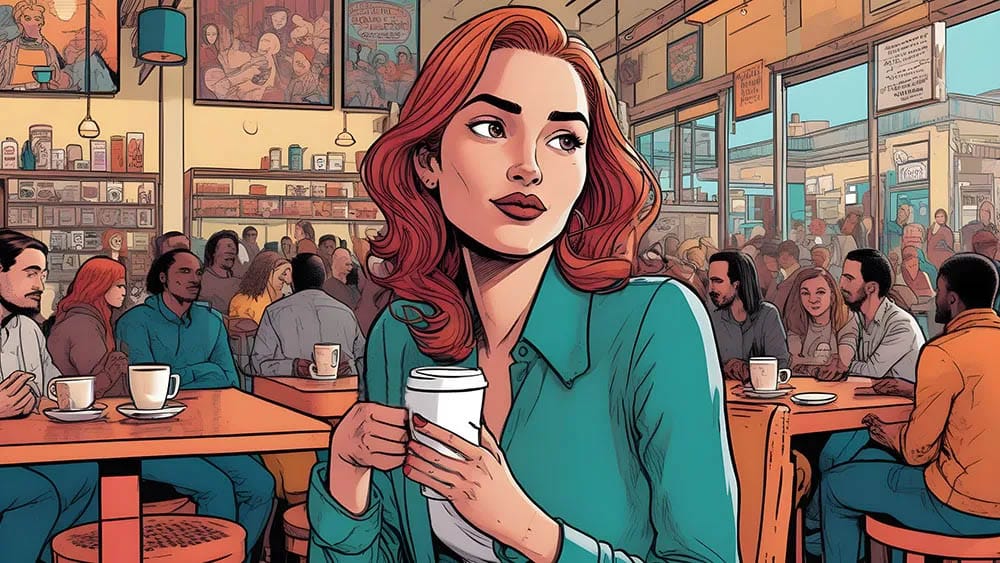
In gratitude, we acknowledge Starbucks for starting something remarkable — the evolution of coffee into a cultural phenomenon that transcends borders. [4, 7, 10]
Third Wave Coffee
The third wave of coffee emphasizes high quality. The beans usually come from individual farms and are lightly roasted to highlight their distinct flavors.
A focus on quality, direct trade, greater emphasis on sustainability, lighter roasting profiles, and innovative brewing methods—all these define the third wave of coffee.
We chase sweetness, complexity, and uniqueness in our blends.

Focus on Quality Coffee
Emerging in the late 20th century, the Third Wave movement challenged the focus on uniformity in coffee.
Key principles of Third Wave coffee:
Focus on high-quality, single-origin beans: Sourcing directly from farms emphasizes freshness, traceability, and fair trade practices.
Preference for lighter roasts: These roasts preserve the unique flavor profiles inherent to the beans.
Diverse brewing methods: From pour-over to espresso, each method is chosen to highlight the specific beans’ characteristics.
Consumer education: Third Wave coffee emphasizes educating consumers about the origin, processing, and brewing of their coffee.
In the world of Third Wave Coffee, the mission is to elevate the coffee experience by marrying craftsmanship, ethical practices, and education, fostering a genuine connection between the consumer and the rich array of flavors inherent in each bean.
Here is a quote from Hoffman that sumarizes the idea on his book The world atlas of coffee:
Coffee has never been better than it is today. Producers know more than ever before about growing coffee and have access to more varieties and specialist growing techniques. Coffee roasters have never before been so likely to appreciate the importance of using freshly harvested coffee beans, and their understanding of the roasting process continues to improve. There are now more and more cafés selling really good coffee, using the best equipment and training their staff more effectively.Hoffman, J. (2018)
Sustainabillity Challenges
While the focus on quality defines the third-wave movement, it doesn’t exist in a vacuum.
The industry faces significant sustainability challenges, including environmental concerns like deforestation and water scarcity, as well as social and economic issues like unfair labor practices and limited access to resources for coffee-producing communities.
The positive impact of the third-wave movement goes beyond the cup. By prioritizing direct trade and ethical sourcing, these cafes contribute to improving the livelihoods of coffee farmers and promoting sustainable practices in the industry.
In essence, third-wave coffee strives for a future where high-quality coffee coexists with environmental and social responsibility.
Coffee Today
The coffee preparation industry continues to evolve today, with coffee shops opening everywhere.
Today, the coffee landscape has evolved, with heightened expectations for a richer, more ethically sourced brew. The journey that began with Peet’s Coffee and Starbucks has transcended borders, leading to a collective demand for better coffee experiences.
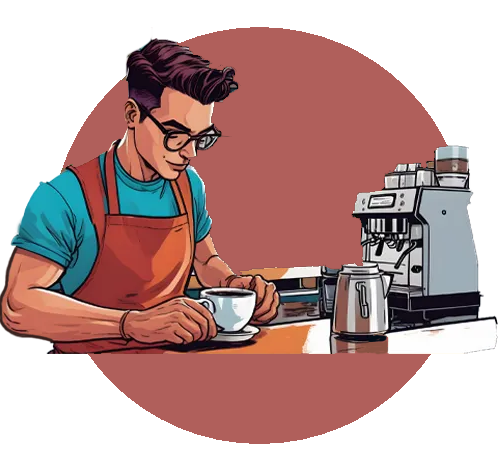
A significant shift in focus has occurred, emphasizing the improvement of coffee producers’ livelihoods, particularly in underdeveloped countries that play a crucial role in global coffee production.
Companies are recognizing their responsibility to foster sustainable and ethical practices throughout the coffee supply chain.
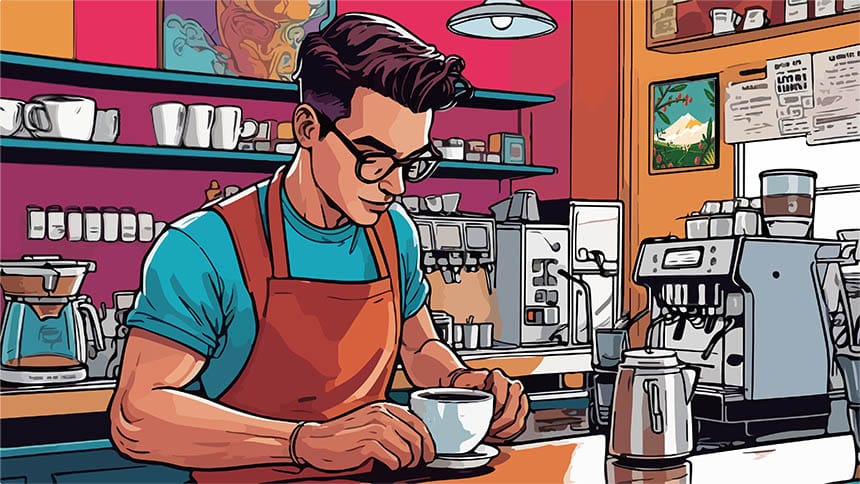
Despite the strides made, the coffee story is far from over. There remains a vast expanse for improvement, especially in promoting equitable relationships between producers growing coffee and the industry.
Efforts to ensure fair wages, ethical sourcing, and environmentally sustainable practices are gaining momentum.
The evolution of coffee reflects a collective consciousness, an awareness that our choices as consumers can shape the future of an industry deeply intertwined with cultures worldwide.
In Conclusion
So, how significant has the impact of coffee been during its global pilgrimage?
Coffee has become a widespread and cherished beverage around the world, contributing significantly to the global economy.

Its cultivation and consumption have permeated various cultures and continue to inspire innovation in flavors, brewing methods, and fostering communities around this beloved drink.
The future of coffee is full of exciting possibilities! We can expect not just new flavors and ways of brewing, but also a closer connection between coffee lovers around the world. This will help everyone appreciate where our favorite drink comes from and the difference it makes.
It’s a chance to be part of a global story, one that cares about making coffee even better, protecting our planet, and caring about the people who bring us this tasty drink.
Coffee had a huge impact on the world.
From ancient tribes chewing on coffee berries and preparing it without roasting, to barista competitions and perfectly designed hearts in our cappuccinos, we all play our part in the history of coffee.
FAQ
Coffee’s origins are in Ethiopia used as a food by local tribes around 8th century, but it was cultivated and traded on the Arabian Peninsula, particularly in Yemen durith the 16th century.
Coffee’s journey most likely began in the forests of Ethiopia around the 9th century AD. While the exact invention is unknown, there’s evidence suggesting the Ethiopian Oromo tribe first used coffee beans as food. Later, by the 15th century, coffee became a popular drink within the Ottoman Empire.
Coffee beans started their journey in Ethiopia’s highlands. Today, most come from the tropical “bean belt” around the equator, including Brazil, Colombia, and Vietnam.
Coffee is a brewed beverage made from roasted coffee beans, the seeds of berries from Coffea plants. It’s a global drink enjoyed for its stimulating effect (thanks to caffeine) and rich flavor.
Coffee’s rise wasn’t instant. It gained steam in the Middle East (15th century) and Europe (17th century) with coffee houses boosting its appeal. By the 18th century, it was a global trade good, and instant coffee in the 20th century made it even more accessible. Today, it’s the world’s favorite beverage.
Coffee reached Europe by the mid-16th century, with Venice as a key entry point. Initially viewed with suspicion, some christians even opposed it. Legend has Pope Clement VIII himself intervening, tasting it, and approving it. This endorsement helped coffee gain acceptance, fueling its rise as a beloved European beverage by the 17th century.
Coffee’s arrival in Asia varied by region. It likely reached Yemen by the 16th century, then spread through trade routes. India saw coffee cultivation around the 17th century, while Southeast Asia came later through European colonists. Today, Asia is a major coffee producer and consumer.
Coffee arrived in the New World by the mid-1600s, likely brought by Dutch or British colonists to New Amsterdam (later New York). While tea remained popular initially, the Boston Tea Party in 1773 sparked a switch to coffee as a patriotic act. This helped solidify coffee’s place in American culture.
From simple social hubs in the Middle East (15th century), coffee houses transformed as they spread globally. Newspapers, games, and lively debates became commonplace. They evolved into centers for intellectual exchange, news, and even political activity, fostering a unique social space across cultures.
History offers a variety of ways to brew coffee. The French Press uses immersion, steeping grounds in hot water. Turkish coffee is finely ground and brewed directly in water, creating a strong, unfiltered cup. The classic pour-over method involves slowly pouring hot water over grounds in a filter for a clean, flavorful brew.
Coffee processing transforms cherries into the beans we know. It typically involves removing the fruit (pulp) around the coffee bean. This can be done by washing with water or drying in the sun. The remaining layers are then dried and hulled before roasting unlocks the coffee’s flavor.
Sources
This article dives deep into the fascinating history of coffee, and ensuring its accuracy was a top priority. To achieve this, I relied on a variety of trusted sources, including books, websites, and research papers, all meticulously selected for their credibility.
Mark Pendergrast’s “Uncommon Grounds” served as a cornerstone for this exploration, providing a wealth of valuable insights.
Each section of this article is supported by at least two sources, indicated by bracketed numbers within the text [1, 2, etc.]. For those who want to learn more, see the complete list of references below.
Websites:- [1] Stamp, J. (2011, October 27). The long history of the espresso machine. Smithsonian Magazine. [smithsonianmag.com]
- [2] Wikipedia contributors. (2023, October 26). Nescafé. Wikipedia. [wikipedia.org]
- [3] Britannica Editorial Staff. (2023, October 26). History of coffee. Britannica. [britannica.com]
- [4] Britannica Editorial Staff. (2023, October 26). Starbucks. Britannica. [britannica.com]
- [5] German Patent and Trademark Office (DPMA). (2021, December 15). Melitta Bentz: 110 Years of the Coffee Filter. [dpma.de]
- [6] National Coffee Association USA. (n.d.). History of Coffee. [ncausa.org]
- [7] Pendergrast, M. (1999). Uncommon grounds: The history of coffee and how it transformed our world. Basic Books.
- [8] Colonna-Dashwood, M. (2017). The coffee dictionary: An A-Z of coffee, from growing & roasting to brewing & tasting. Octopus.
- [9] Weinberg, B. A., & Bealer, B. K. (2001). The world of caffeine: The science and culture of the world’s most popular drug. New York: Routledge.
- [10] Hoffmann, J. (2018). The world atlas of coffee: From beans to brewing – Coffees explored, explained and enjoyed. Octopus Publishing Group.
- [11] Wayessa, B. S. (2011). Buna Qalaa: A quest for traditional uses of coffee among Oromo people with special emphasis on Wallaga, Ethiopia. African Diaspora Archaeology Newsletter, 14(3), 3-9.
- [12] Teso, S., Ayehu, A., Mohammed, K., Kuto, L., & Fufa, D. (2019). Coffee Ceremony of the Macha Oromo in Jimma Zone, Ethiopia. Journal of Tourism and Hospitality, 8(2), 1-8.
- [13] Montagnon, C., Isnard, P., Hoarau, J., Noirot, M., & Leroy, T. (2016). Authentication of Coffea arabica Varieties through DNA Fingerprinting and its Significance for the Coffee Sector. Journal of AOAC International, 103(2), 325–336.
- [14] Massachusetts Historical Society. (John Adams to Abigail Adams, July 6, 1773). John Adams to Abigail Adams, 1774: [masshist.org]
- [15] Jefferson, T. (1824, February 14). To Edmund Rogers [Letter]. In Founders Online (National Archives). [founders.archives.gov]

Greetings, I’m Alexandros, and this is your invitation to my coffee haven. The essence of this blog is simple yet profound: to craft the best in-depth, fact-checked articles on every facet of coffee. Expect a rich blend of recipes, guides, and reviews.

Amazing work! The way you used the illustrations thoughtout the article made the reading experience very smooth and enjoyable.

Thank you so much Marianna! I’m really glad to hear that the illustrations added to your reading experience. I put a lot of thought into making the content not just informative but visually engaging as well. Your feedback means a lot!

Amazing what you have done here! The chapters are so interesting and the illustrations are top-notch! Maybe we can collaborate down the caffeinated road. Best, Regan.

Thank you so much, Regan! I’m thrilled you enjoyed the chapters and illustrations—it means a lot! Your coffee art book seems like an amazing and insiring idea, – let’s definitely collab! ☕️

Really enjoyed diving into this! The combination of detailed history and visuals made it easy to follow and super engaging. Awesome!

Thanks for your feedback! I’m glad you enjoyed the article. We’ve got a lot more illustrated articles coming in, so I hope you stay tuned for those!

Drop a Comment